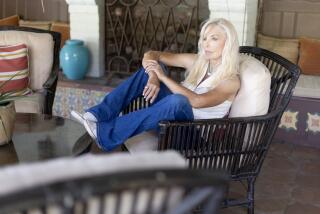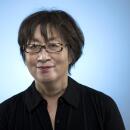Ruth S. Adams, 81; International Peace, Arms-Control Activist
- Share via
Ruth Salzman Adams, an arms-control activist and a former longtime editor of the Bulletin of the Atomic Scientists, who devoted most of her life to ensuring that a broad array of scientists and scholars focused on solutions for world peace, died Friday of cancer at her La Jolla home. She was 81.
Adams was known in international peace circles as the keen mind behind projects as diverse as an insect physiology research institute in Africa and a grant program that sponsored scholars posing alternatives to Cold War orthodoxies.
What often motivated her were the connections she saw between such seemingly unrelated efforts. She recognized, for instance, that world harmony might hinge as much on an entomology research center on a continent plagued by insect-borne disease as it might on overt disarmament efforts.
“She was very interested in nuclear weapons, but also understood that the issues of poverty and development in Third World countries were as much a part of people’s sense of security ... or insecurity as nuclear weapons are in the developed world,” said Kennette Benedict, who succeeded Adams as director of the international peace and security program of the John D. and Catherine T. MacArthur Foundation in Chicago.
Adams was an early participant in the Pugwash peace movement, which brought together American and Soviet scientists concerned about the nuclear threat. She was the only woman present in 1957 at the first Pugwash conference in Nova Scotia, sponsored by such eminent scientists as Albert Einstein and Linus Pauling.
“She was as knowledgeable as many of the Pugwash participants, even though she was not a scientist,” said Victor Rabinowitch, a friend of 50 years and chairman of the Bulletin of the Atomic Scientists. “She really believed in the importance of scientists in political roles. She held that view until her death -- that scientists had a unique responsibility to inform the public about the dangers of nuclear war.”
Adams was born in Los Angeles, the older of two children. She grew up in mining camps in Nevada because of her father, a mining engineer, who, she once told the Washington Post, “was always looking for a pot of gold and never found it.” He abandoned the family when she was quite young. Her mother supported Adams and her sister by becoming a rural visiting nurse in Minnesota.
Adams enrolled at the University of Minnesota in 1941 with thoughts of becoming a lawyer. She left the university the following year for a job as recreation director at an Oregon shipyard, but was fired after she organized an interracial dance.
She returned to Minnesota and married Mark Skinner, with whom she had two daughters. They were divorced in 1951, shortly after moving to Chicago.
Adams went to work in various staff positions at the University of Chicago, an important center of research for the Manhattan Project -- the program to develop the atomic bomb. She became acquainted with many of the scientists who had played a role in the birth of the atomic age and immersed herself in the debates over how to balance academic freedom against the exigencies of global security in the nuclear era.
Such concerns fueled the debut in 1945 of the Bulletin of the Atomic Scientists, which was founded by Manhattan Project scientists at the university and became famous for its doomsday clock gauging the imminence of nuclear disaster. Adams became a research assistant to Eugene Rabinowitch, the bulletin’s first editor, in 1953. That same year she married Robert McC. Adams, an archeologist and a future provost of the University of Chicago.
Four years later, she attended the first Pugwash conference, which was attended by 22 eminent scientists from 10 nations, including Japan, China and the Soviet Union. Although she had no background in physics -- she had studied law, philosophy and sociology -- Adams held her own in that daunting group.
“She was a feminist before it was proper to be a feminist,” said Victor Rabinowitch, Eugene’s son. “I don’t think she ever recognized the idea that women were somehow secondary to men in anything.”
Adams eventually would serve two stints as editor of the Bulletin -- from 1961 to 1968 and again from 1978 to 1983. She became a player in her own right at the Pugwash conferences.
Through these involvements she developed an impressive network of experts who were a Who’s Who of the scientific world. Her contacts combined with a savvy assessment of the research and determination to reduce global conflict eventually led her to the MacArthur Foundation.
In 1984, she became director of its new program on peace and international cooperation. She brought together such top-ranked scientists as physicist Murray Gell-Mann and Jerome Wiesner, a former president of MIT, to develop a grant-making program that would foster new approaches to reducing the threat of nuclear annihilation.
During her seven years as director, Adams helped dispense $133 million to 655 recipients, from institutions such as Harvard and Cornell to individuals such as Pentagon Papers whistle-blower Daniel Ellsberg. She encouraged scholarship in fields not traditionally associated with international security, such as anthropology, sociology and literature.
Along the way, Adams made it a priority to engage younger generations in the mission of peace. She had a special attachment to the student Pugwash movement, and was a mentor to many women who became prominent in the peace and conflict-resolution field.
“Ruth caused one to think, ‘What should I be doing, what are the highest priorities?’ said Gloria Duffy, a deputy assistant secretary of Defense in the Clinton administration, who now is president and chief executive of the San Francisco-based Commonwealth Club, the nation’s largest and oldest civic forum. “She was extremely principled, extremely blunt and extremely focused on improving the human condition,” Duffy said.
That spirit led to Adams’ role in launching the International Centre of Insect Physiology and Ecology in Nairobi, Kenya, in 1969. Over the past three decades, it has trained more than 160 African scientists and thousands of farmers in issues related to pest management. It also has developed pest-resistant plant varieties, as well as methods for biological control of insects that damage crops and carry disease.
Adams kept her job at the MacArthur Foundation when her husband was appointed secretary of the Smithsonian Institution in 1984. She was probably the only Smithsonian first lady who smoked a pipe, which she took up in the 1960s after spending time with some Danish women who smoked.
“She found that was a way to break into those male societies” of disarmament experts and scientists, Robert McC. Adams said. He said it may also have caused her lung cancer, which was diagnosed in August.
In addition to her husband, Adams is survived by three daughters, Gail Lorien of Oakland, Beth Skinner of East Otis, Mass., and Megan Adams of San Francisco; and three grandchildren.
More to Read
Sign up for Essential California
The most important California stories and recommendations in your inbox every morning.
You may occasionally receive promotional content from the Los Angeles Times.











